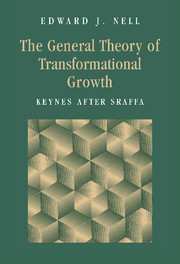Book contents
- Frontmatter
- Contents
- Preface
- Acknowledgments
- Part I History or equilibrium?
- 1 The idea of Transformational Growth
- 2 The stylized facts of the old business cycle and the new
- Part II Method and approach: the active mind
- Part III Money and the Golden Rule
- PART IV The wage-profit trade-off
- Part V Investment and Mass Production
- Part VI Money and fluctuations in the modern economy
- Conclusions
- Bibliography
- Index
1 - The idea of Transformational Growth
Published online by Cambridge University Press: 21 January 2010
- Frontmatter
- Contents
- Preface
- Acknowledgments
- Part I History or equilibrium?
- 1 The idea of Transformational Growth
- 2 The stylized facts of the old business cycle and the new
- Part II Method and approach: the active mind
- Part III Money and the Golden Rule
- PART IV The wage-profit trade-off
- Part V Investment and Mass Production
- Part VI Money and fluctuations in the modern economy
- Conclusions
- Bibliography
- Index
Summary
An equilibrium approach to the economy necessarily underplays change. The conventional wisdom looks for equilibrium configurations and so has missed a highly visible pattern of change that has characterized virtually all major capitalist economies. According to this pattern, agricultural productivity rises faster than demand, so that labor shifts out of agriculture, moving first to the cities, then to the suburbs. Manufacturing increases its share of employment, then levels off, and eventually finds its employment share declining. Within manufacturing the capital goods industries increase in importance relative to consumer goods. Labor employed in services increases, but at a certain point the services change character, shifting from household and personal to business and financial. Similar changes take place in the proportions of output. The share of government in output and employment at all levels rises, then levels off. Within government the share of transfers and welfare rises. Nonprofit acitivities rise relative to the rest of the economy. All these changes take place slowly but steadily, and can be observed whether the economy is booming or slumping. But they are incompatible with the idea of steady growth and cannot be properly understood if we think in such terms.
Nor are these the only changes. At least as important are the changes in the way markets work, in their pattern and manner of adjustment. As we shall see in detail later, prior to World War I markets adjusted primarily through price changes; following World War II, the dominant adjustments took place through changes in output and employment.
- Type
- Chapter
- Information
- The General Theory of Transformational GrowthKeynes after Sraffa, pp. 3 - 36Publisher: Cambridge University PressPrint publication year: 1998



